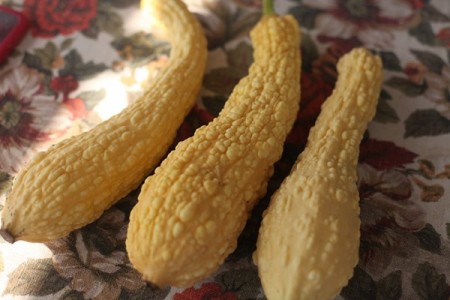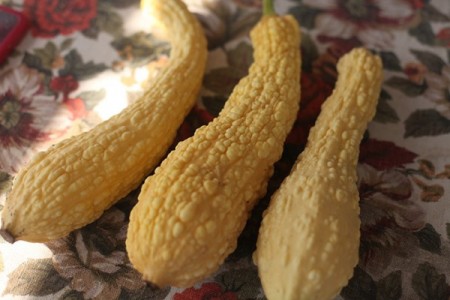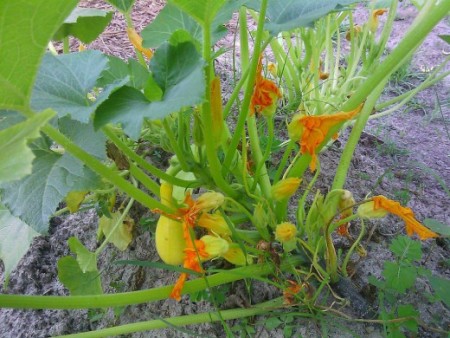Kruknek appeared in my beds by accident: knowing my passion for garden curiosities, one summer resident from St. Petersburg sent me seeds. From the annotation on the bag I learned that kruknek is the best dietary food product, prevents obesity, removes cholesterol, and is superior in nutritional content to zucchini and squash.
Suitable for fresh consumption and all types of processing.Brief information about the plant and a beautiful picture on the bag was enough for an instant decision: I will grow it!
Cultivation of crookneck
I sowed two seeds in peat pots to get thirty-day-old seedlings, and decided to sow the third - the plumpest - directly into the ground. Looking ahead, I admit that I was unable to grow seedlings in the window.
The seedlings grew quickly, but, having reached a height of 50 centimeters, they began to wither: they did not have enough land in small peat pots and light. It was too early to plant seedlings at the dacha, but they were simply suffering in the window. Even transplanting into the ground in May did not help: the crooknecks were sick for a long time and did not grow.
The third seed, without germinating, was sown directly into the ground. I dug a hole at the edge of the cucumber bed with the bayonet of a shovel, filled it with a mixture of rotted cow manure and garden compost, watered it well and planted the seed to a depth of three centimeters.
The surface of the hole was sprinkled with sawdust to prevent the soil from drying out. A week later the seed sprouted. She covered the seedling with a five-liter plastic container, cutting off the bottom and unscrewing the lid to allow air to enter. To prevent the container from being blown away by the wind, the sides were sprinkled with earth. After just a week, the crookneck felt cramped under the plastic cover, and I removed the container.
I watered my miracle plant often at the beginning of growth and fruit set (like cucumbers). By mid-summer, when the crookneck had developed a strong root system, it was watered less frequently—once a week. Soon the torticollis (the second name of the plant) bloomed with large orange gramophones, very similar to pumpkin ones.
The flowers are male and female, but fortunately the weather was favorable, pollination took place without my help. During the season, I did not feed the plant with anything, only in September I poured about a glass of wood ash into the hole and watered it.
The light yellow fruits were carefully cut at the stage of milky-waxy ripeness, when they were 10-12 cm long. Early picking stimulated the formation of more and more new fruits. I didn’t pinch the lashes (I wanted to see what would happen) and it turned out to be right.
As I found out later, kruknek is botanically very close to zucchini and pumpkins. Its leaves are large, like those of a pumpkin, and its vines are shorter than pumpkin ones - about a meter. The torticollis, like all pumpkins, will never produce more fruit than it can feed, so there is no need to pinch the vines.
But if you want to grow “outstanding specimens” for exhibition or interior decoration, the number of fruits on the plant can be reduced. For example, I really wanted to see what fully ripe fruits look like.
I selected three crooknecks from the garden bed and, in order to isolate them from the ground, placed planks under them. And at the end of October, in order to harvest the harvest, we had to cut off the stalks. The skin on the fruit was also very hard: it was impossible to cut it with a knife.
The beautiful fruits weighed from a kilogram to five hundred grams. I took them home. They looked great on a shelf with flower pots, giving the warmth of a bygone summer in the middle of winter.
The first experience of growing crookneck will clearly not be the last: I want to see this crop in my beds every year. Moreover, the plants do not require much attention. The main thing for them is plenty of sun, well-fertilized soil, and timely watering. It is very important that it is not crowded: 1.5 m between plants and the same amount between rows.
Kruknek is best grown by direct sowing of seeds in mid-May. The seeds are planted to a depth of three centimeters. You can sow both dry and germinated seeds.
The plant does not tolerate frost and is generally heat-loving.The optimal temperature for its development is considered to be +23 +25 degrees. But the plants withstood last year's heat.
In cooler climates, torticollis is grown from seedlings. 25-day-old seedlings grown in large peat pots are planted in open ground.
The fruits ripen 50-55 days after emergence and produce a harvest before frost.
In summer, whiteflies can pose a serious danger and are difficult to control.
Kruknek can be affected by powdery mildew. I try to overcome the disease in the early stages by spraying large leaves with a folk remedy: add a glass of milk and 5 ml of brilliant green to 10 liters of water. If it doesn’t help, I tear off the diseased leaves.
G. Galinda, Volgograd
Article from the section “And I do this…”
Assorted vegetables for the winter
At the bottom of a sterile jar I place herbs and spices: black peppercorns, 2-3 cloves, an umbrella of dill, 2-3 cloves of garlic, parsley, celery, basil, a sprig of lemon balm. Then I mix vegetables: cucumbers, peppers, tomatoes, zucchini, squash, crookneck. After this, I fill the jars with boiling water and let them stand for 10-15 minutes. You can fill the jars with boiling water again, but the second time I fill the vegetables with brine (1.5 tablespoons of salt and sugar per liter of water). Instead of vinegar, I pour in 2 tbsp. spoons of vodka and cover with thick plastic or screw caps. I immediately wrap the jars in newspapers and a blanket. After a day, when the pieces have cooled down, I put them in the refrigerator, and in the fall I transfer them to the cooled garage basement.




 CUCUMBERS NEVER GET SICK, I'VE BEEN USING ONLY THIS FOR 40 YEARS! I SHARE A SECRET WITH YOU, CUCUMBERS ARE LIKE THE PICTURE!
CUCUMBERS NEVER GET SICK, I'VE BEEN USING ONLY THIS FOR 40 YEARS! I SHARE A SECRET WITH YOU, CUCUMBERS ARE LIKE THE PICTURE! You can dig a bucket of potatoes from each bush. Do you think these are fairy tales? Watch the video
You can dig a bucket of potatoes from each bush. Do you think these are fairy tales? Watch the video
 How our fellow gardeners work in Korea. There is a lot to learn and just fun to watch.
How our fellow gardeners work in Korea. There is a lot to learn and just fun to watch. Eye trainer. The author claims that with daily viewing, vision is restored. They don't charge money for views.
Eye trainer. The author claims that with daily viewing, vision is restored. They don't charge money for views. A 3-ingredient cake recipe in 30 minutes is better than Napoleon. Simple and very tasty.
A 3-ingredient cake recipe in 30 minutes is better than Napoleon. Simple and very tasty. Therapeutic exercises for cervical osteochondrosis. A complete set of exercises.
Therapeutic exercises for cervical osteochondrosis. A complete set of exercises. Which indoor plants match your zodiac sign?
Which indoor plants match your zodiac sign? What about them? Excursion to German dachas.
What about them? Excursion to German dachas.